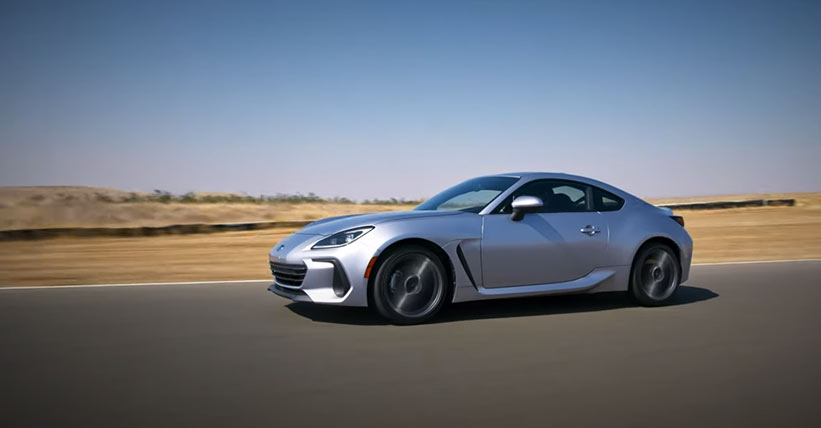Since its introduction in 2012, the Subaru BRZ has focused on providing excellent handling. We have heaped praises on this car and rightly so. Small, light, agile, with good suspension, good balance, low price, the capacity to carry four tires with the rear seats folded - these are the components that form a fantastic sports car. Bear in mind, we place it in a higher position than the McLaren (and definitely higher than a Lamborghini) in the 2012 Best Driver's Car ranking. However, the design was a missed opportunity. Unfortunately, the first generation BRZ had bizarre headlights, fake vents, softness to the rear end that made many people assume this was a front-wheel-drive vehicle.
With a focus on affordability and lightweight agility instead of top horsepower and luxury, the 2022 generation Subaru BRZ is still a great sports car for everybody. The complete change in the design of this rear-drive-only coupe becomes an exceptional addition to Subaru's lineup focused mostly on all-wheel-drive vehicles. Having a 228-hp naturally aspirated flat-four, the BRZ is stronger and more powerful than it used to be, which to some extend addresses some of our main complaints. Add to that the lower centre of gravity in addition to the feathery curb weight and the assertively styled 2+2 hatchback that is designed to ensure a comfortable seat experience that is classic for all fantastic sports cars.
With a brand new interior layout that offers advanced technology but preserves the practicality its predecessor is known for, the 2022 BRZ is ready to conquer the first place as a king of affordable sports cars and compete with its main rival - Mazda MX-5 Miata. The 2022 BRZ model presents the new generation of Subaru's lightweight sports cars. In addition to the new coupe that sits around 0.5 inches lower and with about a 1 inch longer span, the bodywork is more distinguished and unique than ever before. Its interior is transformed with much more technology without compromising with practicality. Driving fans will welcome a brand new 2.4-litre flat-four-cylinder engine that is more powerful than the 2.0-litre engine version of the predecessor.
Power remains routed to the rear wheels through a six-speed manual or a six-speed automatic transmission. Subaru describes the new coupe with a lower centre of gravity and an estimated curb weight of just under 2900 pounds that it is almost perfectly distributed between front and rear. All these improvements in addition to the stiffer structure seem to make the new generation BRZ more enjoyable to drive than before. Its traction and stability system features five different settings. For even more control, the driver can deactivate the whole system. Each model of this line comes standard with a limited-slip rear differential. The Premium and the Limited models are the only two that differ with a set of 17-inch wheels for the Premium model and 18-inch wheels for the Limited model.
If you have been waiting to get a turbo version as most BRZ lovers to happen to be - you are going to be disappointed. There is not one. Instead, Subaru replaced the BRZ's current 2.0-litre flat-four engine with a new 2.4-litre engine, however, with exactly the same settings. It includes Toyota's D-4S interface and manual fuel-injection system, 13.5:1 compression ratio, and chain-driven double-overhead cams with variable time. "It is essentially an Ascent engine with no turbo," Infante said.
That is 18 % more torque, and it strikes at a much lower rpm. In comparison, the previous generation BRZ’s torque peak was at 6400 rpm. This pretty much explains the new BRZ's more powerful pull from these second-gear corners. It will be interesting to see whether this extra power can find the coupe down to the five-second zone.
Both the six-speed manual transmission plus a semi-automatic transmission will be offered, along with automatic transmission for the new Sport version with faster response, rev-matching, and much more competitive equipment choice during hard driving. A limited-slip differential will likely be standard across the range.
As for the interior, the BRZ preserves its driver-centric layout and 2+2 seating configuration, but the current cabin boasts a more contemporary aesthetic with improved technology. Facing the driver is a brand new 7.0-inch completely digital gauge cluster which makes the tachometer the main attraction, along with a circular readout switching to a linear graph in the Track drive mode.
A set of heavily bolstered front seats ensures to keep passengers firmly and safely in place during hard cornering, and they are complemented with red accents in synchrony with the coupe’s racy intentions. Along with the reduced seating position, Subaru ensures the BRZ guarantee outstanding forward visibility because of the thin front roof pillars. A spacious cargo area with enough room for four wheels (for track days) with the rear seats folded, remains a pillar of this coupe's practical nature.
